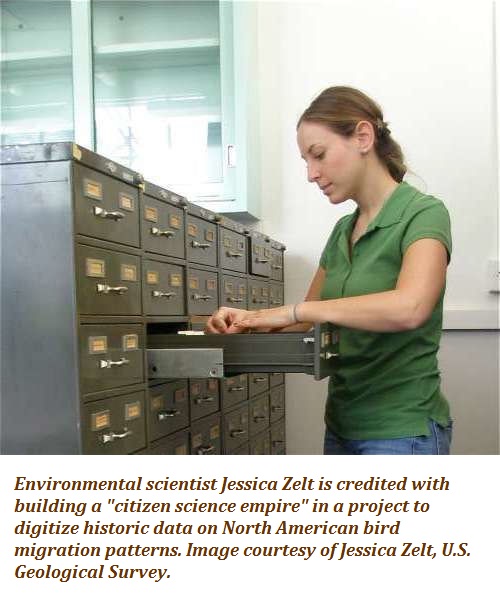Has the First Cybermurder Already Happened?
The recent spate of attacks ranging from corporate theft to denial of service for gamers has brought new attention to cyberwarfare and cybercrime. The potential for even online murder was one of the forecasts by the Internet Organized Crime Threat Assessment (iOCTA) report. But it’s possible that a cybermurder has already taken place, observes foresight analyst Richard Yonck in his recent post on the Scientific American blog.

“When hackers cause widespread power outages as they may have done in Brazil nearly a decade ago,” Yonck writes, “isn’t it likely that someone among the millions affected will die due to a lack of electricity? True, such deaths wouldn’t have been specifically targeted, but to any victims and their families that distinction is of little comfort.”
FBI futurist Marc Goodman, author of the forthcoming Future Crimes, adds that even six years ago, “terrorists were using search engines, like Google, to determine who shall live and who shall die,” as he recently noted on Tim Ferriss’s podcast. And technologies that can do more damage are now in more hands: 3-D printers can produce military weapons and bioterrorists can download the recipes for diseases from the Internet.
Indeed, the biggest potential threat from cybercrime is how easy it is becoming for more people to commit it, Yonck argues. We should therefore “give greater consideration to the negative and unanticipated consequences of our new technologies as early in their development as we possibly can, in order to better address their vulnerabilities and shortcomings,” he advises.
And Goodman reminds us that we can do more to protect ourselves from cybercrimes by using common sense: For instance, don’t open links or attachments in e-mails from unknown sources, keep your security software up to date, don’t use the same user names and passwords for all your accounts, and invest in a subscription to a virtual private network if you frequently use public Wi-Fi.
Sources: “Facing Up to Online Murder and Other Cybercrimes” by Richard Yonck, Scientific American Blog (December 3, 2014). “Marc Goodman, FBI Futurist, on High-Tech Crime and How to Protect Yourself,” The Tim Ferriss Show (podcast, December 9, 2014).
Image credits: Surian Soosay (Internet riot police), Tim Reckmann (Anonymous), via Flickr, Creative Commons. Collage by C. G. Wagner for AAI Foresight SIGNALS.
Signals: bioterrorism, cybercrime, hackers, security
Satellites Reveal a Global Night-Light Gap
Not only are American cities brighter at night than German cities are, but the night-light gap actually increases with city size: Larger U.S. cities emit more nighttime light per capita than smaller cities do, while larger German cities emit less.
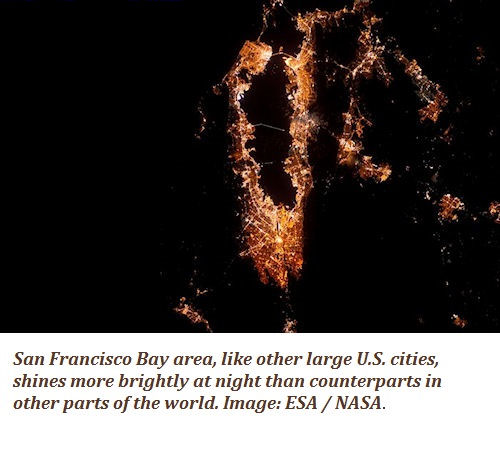
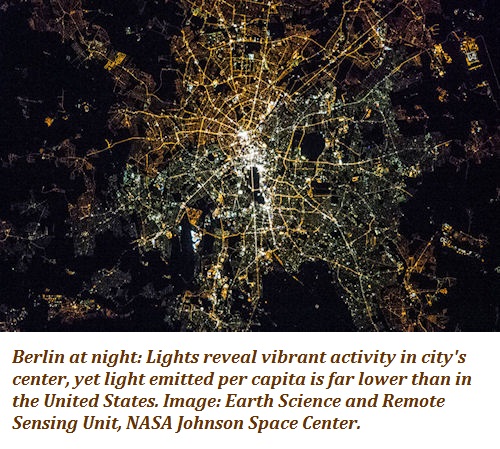
These findings are the product of new high-resolution night imaging made possible by the European Space Agency’s NightPod instrument, deployed in 2012. Work conducted by the Remote Sensing section of the German Research Center for Geosciences also reveals significant differences in the world’s light sources: Airports and harbors generate most of the night light in megacities of the developing world, while sports stadiums and leisure centers light up the night in wealthier cities of Europe.
The brighter lights of bigger U.S. cities may be due to differences in the types of lamps used, in the architectural features of the cities, or in the amount of trees or other foliage available to block light traveling upward.
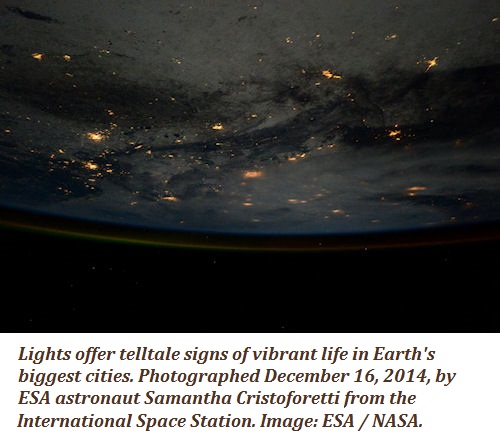
The findings also offer data on electricity use and suggest ways to improve lighting efficiency in the world’s cities: Installation of efficient LED lamps, for instance, could reduce future consumption—and minimize light pollution by directing less light upward into the night sky.
Source: GFZ German Research Center for Geosciences, Helmholtz Center, Postsdam.
Reference: C.C.M. Kyba, S. Garz, H. Kuechly, A. Sánchez de Miguel, J. Zamorano, F. Hölker (2015). “High-resolution imagery of Earth at Night: new sources, opportunities, and challenges.” Remote Sensing, 2015, 7(1), 1-23; doi:10.3390/rs70100001
Signals: astronomy, cities, efficiency, energy, imaging
Boldly Forecasting Emergency Medicine in the 24th Century
Humans will be living longer and healthier lives three centuries from now—at least until we’re called into battle against Klingons.
The 50-year-old Star Trek science-fiction franchise has inspired numerous innovations, from fax machines to flat-screen monitors. Now, a team of scholars in Vienna is speculating on how emergency medicine may evolve by analyzing more than 500 episodes from the various Star Trek series.
We’ll still die from cardiac arrests in the future, according to study leader David Hörburger of MedUni Vienna, but the causes will be more related to traumatic events, such as exposure to “energy weapons” and poisoning, rather than to general medical problems, such as arrhythmias.
The study also offers guidance for treatment of cardiac arrests; today, patients have a better chance of survival if they are already in the hospital, while those home alone have the worst survival rates. By contrast, cardiac arrest patients in Star Trek’s twenty-fourth century benefit from teleportation and the hand-held diagnostic “tricorder” device—fictional inventions that are already inspiring today’s medical innovators.
Source: Medical University of Vienna
Reference: D. Hörburger, J. Haslinger, H. Bickel, N. Graf, A. Schober, C. Testori, C. Weiser, F. Sterz, M. Haugk. (2014). “Where no guideline has gone before: Retrospective analysis of resuscitation in the 24th century.” Resuscitation (December: Volume 85, Issue 12, Pages 1790–1794) dx.doi.org/10.1016/j.resuscitation.2014.10.008.
Signals: health, medicine, science fiction, Star Trek
Rooftop Resources Project: Report from Timothy Mack
The practical realities of building sustainable networks are coming to life in Oakland, California, under the stewardship of a nonprofit group called Bay Localize as part of its Rooftop Resources Project.
Working with PlaceWorks, a Berkeley design and planning consultancy, Bay Localize is utilizing GIS tools to conduct a search for Green Roof candidates that might host hydroponic gardens, photovoltaic panels, and rainwater-collection systems. Some roofs could be viable for more than one of these uses, although slanted roofs have not worked well for garden sites. (Energy generation requires the slant to be in the right direction.)
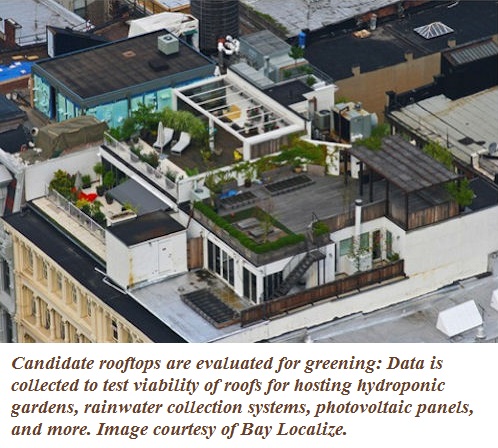
The project team then collects a deeper layer of data on the ranges of building use and construction, roof access and materials, structural integrity, and surrounding room for ground-level water-collection tanks. This data can be collected and collated using hand-held devices and then used to calculate gallons of water, kilowatts of electricity, and pounds of vegetables potentially produced by any one rooftop. Read more.
Timothy Mack is the managing principal of AAI Foresight Inc. This report was excerpted from Foresight SIGNALS Blog. Image courtesy of Bay Localize.
Signals: collaboration, energy, gardens, green buildings, hydroponics, photovoltaics, sustainability, urban planning, water
Futurists at Work, Foresight in the News
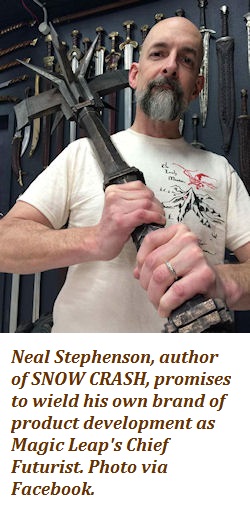
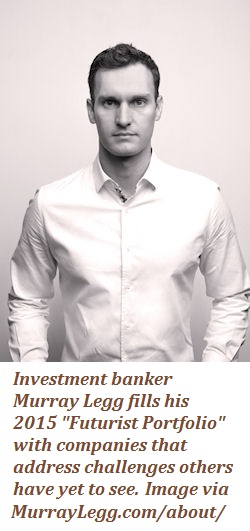
Sci-Fi Author Named Chief Futurist: Magic Leap Inc. has tapped science-fiction author Neal Stephenson, who coined the concept of the “metaverse,” to help develop the technologies behind the company’s products, largely related to games and how users experience artificial worlds. “Neal is a true visionary and the very first to conceptualize a social, virtual world in a coherent way,” said Magic Leap founder, president, and CEO Rony Abovitz in a press release. Stephenson responded wryly on the company’s blog: “‘Chief Futurist’ runs the risk of being a disembodied brain on a stick. I took the job on the understanding that I would have the opportunity to get a few things done.”
The Futurist Portfolio: South African investment banker Murray Legg believes U.S. companies will continue their momentum in 2015, with technology, health care, and industry delivering “great returns, likely into the low double digits,” he writes on his blog. His Futurist Portfolio comprises companies led by visionaries, “companies that are looking into the future and bringing solutions to market that address the challenges the middle of the bell curve aren’t entirely aware of as yet.” His picks include Naspers, Novo Nordisk, Google, Apple, Alibaba, Tesla, and Airbus. Read: “2015—My Stock Portfolio View,” Murray’s Blog (December 6, 2014).
A Futurist for the Birds? Environmental scientist Jessica Zelt’s work enlisting citizen scientists to produce a database of bird sightings is featured in Audubon magazine. Begun in 2008, the project to digitize the North American Bird Phenology Program now involves more than 2,500 volunteers transcribing handwritten reports as much as 100 years old. Unlocking this historic data promises to help scientists understand the effects of climate change on bird migration. Read: “Three Generations of Citizen Science: The Futurist” by Rachel Nuwer, Audubon (November-December 2014).
